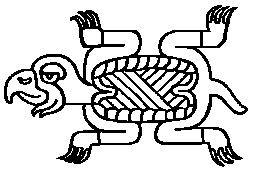

 http://www.txinfinet.com/mader/planeta/0296/0296ecchirije.html (PC Press Internet CD, 03/1996)
http://www.txinfinet.com/mader/planeta/0296/0296ecchirije.html (PC Press Internet CD, 03/1996)
Did you know that Ecuador's early coastal peoples were important for the development of the famous cultures in Central America and Peru? The Bahia Culture - known as the "Phoenicians of the Americas" - set up important trade routes and were responsible for transfer of ideas and technologies that helped the complex social organizations of the neighboring countries to succeed.
Sailors and merchant traders in search of the sacred Spondylus and mother of pearl shell arrived at this site aboard balsa wood sailing vessels. These seafaring merchants traded skillfully crafted ornaments or whole shells as far north as Mexico and as far south to Chile, for gold, copper and other previous items.
We are truly interested in making Bahia de Caraquez known to the travel world - especially the archaeological site of Chirije. It would be great for students interested in ecology and archaeology to visit this site and for volunteer groups like Earthwatch to assist in the funding of future investigations of this site.
The following are some tours that visitors interested in the local environment can enjoy:
Visit the "Isla de los Pajaros," an island inhabited by a variety of bird species, such as the Frigate, Egret and Pelican. Navigate through groups of mangroves and observe the unusual natural formation of islands, such as the "Isla Corazon." This island is a naturally formed in shape of a heart. It served as a place of local worship according to sixteenth century Spanish chronicles.
En route to the shrimp ponds, navigate the estuary in private touring boats and discover a unique mangrove ecosystem. Visit the "Isla de los Pajaros," a small island inhabited by an array of bird species and "Isla Corazon."
Tour the area and learn about current aquatic techniques and the commercialization of this product. Of course, we invite you to sample the traditional fresh shrimp dish, "Cebiche."
Just fifteen minutes from Montecristi lies another artesian town known as La Pila. La Pila is regionally known for its indistinguishable replicas of pre-Columbian ceramics. Choose from an array of ceramics that represent various coastal civilizations, some dating back 3000 years.
The mission was led by French astronomer, Charles Marie de la Condamine, who in that same year, discovered the equatorial line here at Punta Palmar, dividing the earth into the Northern Hemisphere and the Southern Hemisphere.
Located just two hours north of Bahia, visit the equatorial monument and its surrounding unspoiled beaches. The spectacular topography of lush forests, mountain ranges and the white-sand beaches of Don Juan make this a magnificent trip.
The author is manager of Bahia Dolphin Tours. He can be contacted via email at archtour@srv1.telconet.net